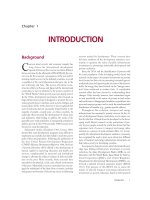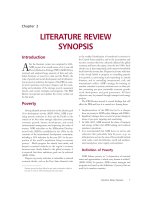The binding of multi functional organic molecules on silicon surfaces 1
Bạn đang xem bản rút gọn của tài liệu. Xem và tải ngay bản đầy đủ của tài liệu tại đây (603.8 KB, 30 trang )
The Binding of Multi-functional Organic Molecules on Silicon Surfaces
1
Chapter 1 Introduction
1. 1 Motivation
Advances in micro-fabrication, which makes possible the manufacture of computer
"chips," have launched us into a new age of technological innovation. Devices such as the
cellular phone and portable computers rely on semiconductor-based microelectronics to
function. The genesis of the innovations required for faster, more powerful computers
and other futuristic applications depends on our ability to fabricate smaller, but more
complex structures in an economically efficient manner. The next challenge will be to
create microelectronic devices that comprise of billion of components but are smaller
than a fingernail [1]. The formation of these intricate structures involves repeated steps of
material deposition and selective removal. As devices decrease in size but become more
complex in terms of material requirements, a molecular understanding of basic chemical
reactions is required [1].
Recently, the marriage of organic molecules with silicon-based devices attracts
much attention [2-6]. It offers potential opportunities to combine high chemical,
mechanical, and thermal stabilities with tailored electronic or optical properties into
existing device technologies [7-10]. However, the physical properties and chemical
nature of these interfacial atoms or molecules are expected to play crucial roles in the
functions and characteristics of devices [1]. Thus, it is essential to understand the
selectivity, configuration, and mechanism in covalent binding multifunctional organic
molecules to silicon surfaces.
The Binding of Multi-functional Organic Molecules on Silicon Surfaces
2
1.2 The Si(111)-7×7 and Si(100)-2×1 surfaces
Silicon crystals have the diamond-like structure, i.e. the atoms are sp
3
hybridized
and bonded to four nearest neighbors in the tetrahedral coordination. The covalent bonds
are 2.35 Å long and each has the bond strength of 226 kJ / mol [11]. When the crystal is
cut or cleaved, bonds are broken, creating dangling bonds at the surface. As a typical
covalently bonded material, the clean silicon surfaces reconstruct in order to reduce the
energy associated with the surface dangling bonds. On Si(100), the surface atoms pair up
as dimers to form a (2×1) reconstruction [12-14]. On Si(111), equilibrium (7×7)
reconstruction with a more complicated DAS (dimer-adatom-stacking) structure is
formed upon thermal annealing [15, 16]. It is worth noting that the dangling bonds are the
origin of the chemical activity of silicon surfaces. Thus, the reactivity of organic
molecules on the silicon surface is intimately connected with the geometric and electronic
structures of the surface silicon atoms.
1.2.1 The structure of Si(111)-7×7
The (7×7) reconstructed silicon surface has been a subject of continued interest for
more than a quarter of a century. Since the first report of a (7×7) LEED pattern by Schlier
and Farnsworth in 1959 [17], numerous structural models have been proposed to account
for this observation over the following 25 years. Ion-scattering experiments [18-19]
provided evidence for a significant rearrangement of the atoms in the deeper layers of the
surface, interpreted by Bennett et al. [19] in terms of a surface stacking-fault. In 1985,
Takayanagi et al. [15, 16] proposed a new structural model for the (7×7) reconstruction
based on the results from transmission electron diffraction (TED) experiments. This
model, referred to as the DAS (dimer-adatom-stacking) model (Figure 1.1), further
The Binding of Multi-functional Organic Molecules on Silicon Surfaces
3
supported by numerous evidences from other surface techniques such as medium-energy
ion scattering [20] and grazing x-ray diffraction [21], is now the most widely accepted
model for Si(111)-7×7. The scanning tunneling microscopic (STM) study of the Si(111)-
7×7 surface by Binnig et al. [22] gave the first real space image including 12 protrusions
per unit cell and deep holes at the corners, strongly favoring the DAS model with
adatoms and corner vacancies.
The dimer-adatom-stacking faulted (DAS) model is schematically presented in top
and side views in Figure 1.1, a unit cell (a rhombohedral-like dimensions of 46.56 Ǻ for
the long diagonal and 26.88 Ǻ for the short diagonal) covering a surface area equivalent
to 49 atoms of the (111) plane. A stacking fault is present in the second atomic layer, but
it affects only one half of the cell (on the left of Figure 1.1). Therefore, the unit cell is
further divided into two half, i.e. the faulted part and the unfaulted [23]. Figure 1.2 shows
the layer-by-layer buildup of the Si(111)-7×7 structure. The first layer contains 12
adatoms so that each one of them saturates three atoms of the second layer. Six of the
second layer atoms remain nevertheless unsaturated, we call them rest atoms. At the third
atomic layer, there are 9 dimers along the edge of the (7×7) structure. One atom is
missing at the corner of the unit cell (i.e. one missing atom per unit cell) which leaves a
place for fourth layer atom, creating the “corner holes”. The most important structural
effect of the reconstruction is a dramatic reduction in the number of surface dangling
bonds in the (7×7) unit cell from 49 to 19 (12 + 6 + 1), 12 arising from the adatoms, 6
from the rest atoms, and one from the corner hole. There are seven types of spatially-
inequivalent dangling bonds in each unit cell: four from the adatoms (corner adatom or
The Binding of Multi-functional Organic Molecules on Silicon Surfaces
4
center adatom on the faulted or the unfaulted halves), two from the rest atoms in the
faulted and unfaulted parts, and one from the corner hole.
1.2.2 Electronic properties of Si(111)-7×7
The seven types of spatially-inequivalent atoms, namely, four adatoms including
corner, center atoms on both faulted and unfaulted halves, faulted and unfaulted rest
atoms, and the corner hole atom, are also electronically-inequivalent. The inherent
differences in the density of electronic states between these atoms are readily
distinguishable in STM images [22]. For example, when the occupied states of the
sample are probed with negative sample bias, the STM images reveal a marked
asymmetry between the two halves of the unit cell [24]. The adatoms in the faulted half
appear to have a higher intensity than those in the unfaulted half due to the difference in
electronic structure caused by the stacking fault [25]. Moreover, in each half of the unit
cell, the three corner adatoms are brighter than the three center adatoms [14]. This
observation is attributed to the charge transfer between adatom and rest atom [26]. Each
center adatom has two neighboring rest atoms, but only one for each corner adatom. The
amount of charge for transferred from a center adatom to the rest atoms is roughly twice
as much as that from the corner adatom. Consequently, the corner adatom has a high
density of occupied states, which accounts for its brighter appearance in the STM filled-
state images. It was shown experimentally and theoretically that each adatom dangling
bond has an occupancy of approximately one-half an electron, whereas each rest atom
dangling bond has two electrons.
It is generally accepted that the dangling bonds are the centers of chemisorption
reactions. As the Si(111)-7×7 surface presents seven types of such bonds, different
The Binding of Multi-functional Organic Molecules on Silicon Surfaces
5
chemical behaviors are expected. One way of quantifying the reactivity of a site is to look
at its capacity to give or receive electrons under the influence of an external potential
created, for example, by an exterior atom. Brommer et al. [27] evaluated this capacity by
the local softness. The greater the density of the empty states (acceptor), or filled states
(donor), around the Fermi level, the greater the softness. The calculation of the softness
on the dangling bonds of the Si(111)-7×7 gave the following results: For electrophilic
reactants (absolute electronegativity greater than that of silicon), the sites apt to give
electrons are, in decreasing order, the corner hole, the rest atoms and the adatoms. The
sites situated on the faulted side have a greater softness than those on the unfaulted. For
nucleophilic reactants (absolute electronegativity inferior to that of silicon), the adatoms
have the greatest tendency for accepting electrons, followed by the corner hole and rest
atoms.
1.2.3 The structure of Si(100)-2×1
The commonly accepted model for the reconstructed Si(100) surface is the dimer
model. The first model of this kind was proposed by Schlier and Farnsworth on the basis
of their observation of a (2×1) low-energy electron diffraction (LEED) pattern [17] and
was confirmed by scanning tunneling microscopic (STM) studies [12-14]. In this model
the density of dangling bonds is decreased by 50% by creating rows of dimers, where
each surface silicon atom bonds to a neighboring atom along the {110} direction using
one of its dangling bonds, as shown in Figure 1.3. The original model was modified by
Levine [28], and later by Chadi [29], who proposed that the dimers could be asymmetric
(buckled, i.e. one member atom is higher from the surface than the other). The discussion
leading to the acceptance of the dimer model was reviewed by Haneman in 1987 [30]
The Binding of Multi-functional Organic Molecules on Silicon Surfaces
6
together with several other models. Many experiments [31-34] and theoretical
calculations [29, 35-39] have been devoted to resolve the question of whether the dimers
are symmetric or asymmetric on perfect regions. There is no consensus yet and though
the majority of the results points toward the buckled dimers model, the symmetric dimers
are favored in several works. The compromise viewpoint expressed in a number of
publications [40-43] implies that as the calculated energy difference between the
symmetric and asymmetric dimers is very small (e.g. only ∼ 0.02 eV according to Ref.
[40]), it is therefore quite possible that both kinds of dimers could coexist on the surface.
The STM observations [12-14] have clarified the situation only partially. STM
images show the presence of both buckled and non-buckled dimers in roughly equal
amounts as well as a high density (∼ 10%) of vacancy type defects (missing dimers). In
defect-free areas only symmetric dimers were observed while buckled dimers appeared to
be stabilized near surface defects. However, the authors [14] pointed out that they were
unable to ascertain whether the symmetric-looking dimers are truly symmetric or whether
the STM image is only sensitive to the time-average position of dimers which may flip
dynamically on a time scale shorter than the STM measurement time. The idea that
buckled dimers may rapidly interconvert with symmetric dimers or simply flip found
theoretical support in Refs. (35, 36).
Moreover, the results of several theoretical works [44-46] showed that biasing
the surface, used in STM experiment, can visibly influence the resulting surface image. In
the case of the 2×1 reconstruction of the Si(100) surface this means that one can expect
STM images to show symmetric dimers even if the dimers in the unbiased surface are
buckled.
The Binding of Multi-functional Organic Molecules on Silicon Surfaces
7
1.2.4 Electronic properties of Si(100)-2×1
In the (2×1) reconstructed surface, adjacent Si atoms pair into dimers, shown in
Figure 1.4a. The bonding configuration within the surface dimers can be formally
described in the terms of a Si-Si σ bond coupled with a π bond [13, 14, 47], analogous to
the C=C double bond of alkenes since C and Si belongs to the same group (group IV),
suggesting a possible similarity of chemical reactivity between them. On the other hand,
the π overlap of the Si surface dimers is poor. This is particularly attributable to the
strained geometry at the surface preventing good spatial overlap of the orbitals needed to
achieve strong π bonding. The pairing energy associated with the dimer π bond on a clean
Si(100) has been estimated at values between 1 and 31 kJ/mol, [47-51] with most
estimates clustering between 20 and 30 kJ/mol; this value is much smaller than the
typical Si bond strength of 226 kJ/mol for bulk Si and 250-310 kcal/mol for silicon
hydrides [11]. In fact, the Si=Si dimer might be regarded as a di-radical [48] as
schematically presented in Figure 1.4(b).
A great number of theoretical calculations [35-39] and experimental
investigations [28-34] confirmed the existence of buckling Si=Si dimer. The buckling
dimer is accompanied by a charge transfer from the buckled-down atom to the buckled-
up. The scheme of this unique surface structure is shown in Figure 1.4(c). Due to its
asymmetry nature, the Si=Si dimer displays both electrophilic and nucleophilic.
1.3 Reaction mechanisms of functional molecules with silicon surfaces
Previous work in this field has been mainly focused on the binding of unsaturated
organic molecules on silicon surfaces [2-6]. Based on the reactive mechanisms, two
The Binding of Multi-functional Organic Molecules on Silicon Surfaces
8
broad areas of organic reaction will be highlighted, including cycloaddition reactions, and
dative bonding and proton transfer.
1.3.1 Cycloaddition reactions
In organic chemistry, one of the most important and widely used reactions to
extend molecular architecture is cycloaddition [52-54]. Cycloaddition are reactions in
which two π bonded molecules approach each other to form a new cyclic structure, losing
two π bonds and producing two new σ bonds in the process. Two typical cyclic addition
reactions are [2+2] and [4+2] cycloadditions. For [2+2] cycloaddition, two alkenes react
to produce a new four-membered ring by the interaction of two π electrons in one of the
alkenes with two π electrons of the other alkenes. The [4+2] addition, also known as
Diels-Alder reaction [52], was named in the memory of Otto Diels and Kurt Alder, who
enjoyed the Nobel Prize honor for their discovery of this mechanism. In this reaction, “4”
represents the four π electrons of conjugated dienes (the simple example is butadiene).
The conjugated diene interacts with alkene to form a new six-memebered ring. In this
cycloadduct, a new C=C double bond is produced in the resulting cyclohexene-like
structure.
The difference in reactivity observed for the [2+2] and [4+2] cycloaddition
reactions can be predicted by a symmetry analysis of the highest occupied molecular
orbital (HOMO) and lowest unoccupied molecular orbital (LUMO) of the reacting
molecules. Such an analysis yields the Woodward–Hoffman selection rules [55]. These
rules dictate that the parity of the p orbital lobes involved in the creation of the new σ
bonds must be identical for the reaction to proceed. As demonstrated in Figure 1.5, [4+2]
The Binding of Multi-functional Organic Molecules on Silicon Surfaces
9
cycloaddition or Diels–Alder reactions are symmetry-allowed while [2+2] cycloaddition
reactions are symmetry-forbidden.
If the analogy made between traditional alkenes and the dimers of Si(100)-2×1
and the adjacent adatom-rest-atom pairs of Si(111)-7×7 surfaces, then it would be
expected that cycloaddition surface products may be observed as a surface reaction
product. The [2+2]-like and [4+2]-like cycloaddition reactions have indeed been
observed on the Si(111)-7×7 and Si(100)-2×1 surfaces.
1.3.1.1 [2+2]-like cylcoaddition reactions
Alkenes, the simple unsaturated organic molecules, bond to Si(100)-2×1 and
Si(111)-7×7 to form a [2+2]-like cycloaddition product. On the basis of their IR
experiments on the adsorption of cis- and trans-1,2-dideuterioethylene on Si(100), Liu et
al. believed that the interaction of ethylene with Si(100)-2×1 is stereospecific and would
follow the low-symmetry pathway [56]. In contrast, the recent scanning tunneling
microscopy (STM) experiments revealed that for the adsorption of trans-2-butene on
Si(100), the [2+2]-like reaction is not stereospecific with a stereoselectivity of 98% and a
small degree of isomerization, implying a diradical mechanism for the gas-surface
reaction [57]. Lu et al. by means of density functional cluster model calculations showed
that the adsorption of ethylene on a Si(100) surface follows a diradical mechanism [58],
proceeding via a σ-complex precursor and a singlet diradical intermediate, consistent
with the STM observation [57]. For ethylene on Si(111)-7×7, the formation of a [2+2]-
like cycloaddition product have been drawn from HREELS [59], photoemission [60, 61],
and STM [62] data. Theoretical studies reveal that the reactions of unsaturated
The Binding of Multi-functional Organic Molecules on Silicon Surfaces
10
hydrocarbons with Si(111)-7×7 through [2+2]-like cycloaddition, including ethylene and
acetylene, along a diradical reaction pathway [63].
Yoshinobu and coworkers [64] first proposed that acetylene is di-σ bonded to the
adjacent adatom-rest-atom pair on Si(111)-7×7 through the [2+2]-like cycloaddition at
room temperature. Synchrotron radiation X-ray photoemission spectroscopy and near-
edge X-ray adsorption fine structure spectroscopy data confirmed the di-σ configuration
via the [2+2]-like cycloaddition [65]. Similar to acetylene on Si(111)-7×7, several
different experimental [66-68] and theoretical [69-71] investigations show that acetylene
reacts with Si(100)-2×1 to form a [2+2]-like cycloaddition as the major surface species.
In part due to their large dipole moments, compounds containing nitrile (C≡N) and
carbonyl (C=O) have attracted considerable attention recently and several studies have
begun to elucidate their rich chemistry on Si(100)-2×1 and Si(111)-7×7 surfaces [72-79].
Tao et al. first concluded that acetonitrile formed a [2 + 2]-like cycloadduct through the
C≡N group as the majority species at low temperature on Si(100)-2×1 [72] and Si(111)-
7×7 [73]. Their conclusions were based on the presence of a ν(C=N) stretching mode
near 1600 cm
-1
. A recent room temperature photoemission and NEXAFS study by
Bournel et al.[74] identified a [2+2]-like C≡N cycloadduct, in agreement with Tao et al.
On the other hand, the calculations of Lu et al. indicate a pathway for the [2+2]-like C≡N
cycloaddition product that passes through a dative-bonded precursor state [75].
The carbonyl group is another functionality which can potentially be exploited to
attach organics to silicon surfaces, white and co-workers found that the majority surface
adducts for acetone, acetaldehyde, and biacetyl at low temperature are [2+2]-like
cycloaddition products through the C=O group using a combination of TPD, XPS, and
The Binding of Multi-functional Organic Molecules on Silicon Surfaces
11
HREELS studies [76, 77]. In a separate theoretical investigation of a series of carbonyl
containing compounds, Barriocanal et al. identified a barrierless pathway that passes
through a dative-bonded precursor state for the [2+2]-like C=O cycloaddition product of
glyoxal [78]. In contrast, Wang et al. were not able to find a barrierless pathway for the
reaction of acetone on Si(100)-2×1 [79] and they proposed that steric interactions of the
methyl groups with the surface likely play a role in hindering the reaction of acetone.
In summary, the majority of unsaturated organic molecules containing just one
functional group chemisorbs on Si(100)-2×1 and Si(111)-7×7 to form a [2+2]-like
cycloaddition product through a low symmetry transition state with a small activation
barrier.
1.3.1.2 [4+2]-like cycloaddition reactions
Konecny and Doren first proposed that more complex alkenes could also form
cycloaddition products [80]. They showed with DFT calculations of 1, 3-cyclohexadiene
that the [4+2]-like cycloaddition should occur on Si(100)-2×1. A binding energy of 54
kcal /mol indicates that there is a substantial thermodynamic driving force for the
formation of the [4+2]-like cycloaddition product. Experimental investigations of 1, 3-
butadiene on Si(100)-2×1 at room temperature with IR spectroscopy, TPD, and NEXAFS
first confirmed the theoretical prediction of Konecny and Doren, showing that the major
surface species is indeed the [4+2]-like cycloaddition product [81]. On Si(111)-7×7, Lu
et al. using the (U)B3LYP cluster model calculations suggested that 1,3-butadiene
undergoes barrierlessly the [4+2]-like cycloaddition adsorption on an adatom-rest-atom
pair by following a stepwise, diradical pathway [63]. This is different from the adsorption
The Binding of Multi-functional Organic Molecules on Silicon Surfaces
12
of conjugated dienes on the Si(100)-2×1 surface, for which ab initio cluster model
calculations predicted barrierless and concerted pathways [82, 83].
Heteroaromatic molecules such as thiophene and furan have all been investigated
experimentally and theoretically on Si(111)-7×7 and Si(100)-2×1 [63, 83-89]. Several
groups have investigated thiophene on Si(111)-7×7 and Si(100)-2×1 and are in general
agreement that a [4+2]-like cycloaddition product comprises the major surface product at
low temperature. For thiophene adsorption on Si(111)-7×7, energy loss peaks near 2190
cm
-1
in the HREELS spectrum for the chemisorbed 2,5-deuterated thiophene, consistent
with alkane ν(-C-D) stretching modes, lead Cao et al. conclude that thiophene looses its
aromaticity through the α-positions in thiophene directly bonding to the surface reactive
sites, forming a [4+2]-like cycloaddition adduct at low temperature [84, 85]. A related
investigation of thiophene on Si(100)-2×1 by Qiao et al.[86], employing XPS, UPS, and
HREELS, also concluded that [4+2]-like cycloaddition product is the major surface
adduct at low temperature. Theoretical studies by Lu and coworkers [63, 83, 87] of
several aromatic molecules further indicated that the [4+2]-like cycloaddition has no
apparent activation barrier and gives the most stable surface product by nearly 36.0 and
34.3 kcal/mol on Si(111)-7×7 and Si(100)-2×1, respectively.
Similar to the case of thiophene, the HREELS spectrum for furan on Si(100)-2×1
and Si(111)-7×7 [88, 89] suggests the coexistence of (sp
3
) C-H and (sp
2
) C-H stretching
modes, indicating furan binding to silicon surfaces via the [4+2]-like cycloadditions at
low temperature. In addition to the [4+2]-like cycloaddition producing the 2,5-
dihydrofuran-like surface species, the dimerization of furan mediated by the surface
The Binding of Multi-functional Organic Molecules on Silicon Surfaces
13
dangling bonds was also evidenced [89], which was further confirmed by recent
theoretical study by Lu et al. [63].
1.3.2 Dative bonding and proton transfer
On Si(111)-7×7 or Si(100)-2×1, nucleophilic / electrophilic reactions are possible
because of the different electronic densities of the reactive silicon sites. Previous studies
[90-108] showed that organic molecules with electron rich or deficient atoms can form a
dative bond with Si(111)-7×7 and Si(100)-2×1. The dative-bonded state is the final
surface species for some simple molecules. In other cases, it acts as a precursor state for
formation of products which are thermodynamically more favorable.
Ammonia, an excellent nitriding agent for the fabrication of oxidation masks, gate
dielectrics, and diffusion barriers in microelectronic devices [109–112], with a lone pair,
reacts with the Si(100)-2×1 and Si(111)-7×7 surfaces via cleavage of an N-H bond,
producing chemisorbed H atoms and NH2 fragments [90-96]. Computational studies
suggested that this reaction proceeds through a mechanism in which the nitrogen lone-
pair electrons interact at the edge of a Si=Si dimer via a kind of transient dative bonding,
which in turn weakens the N-H bond and leads to dissociative adsorption [97, 98].
Several groups have investigated the bonding of organic amines on Si(100)-2×1
and Si(111)-7×7 in an effort to understand the reaction mechanisms on these surfaces [99-
108]. On Si(100)- 2×1, the most important factor influencing the final surface product is
the presence of an N-H bond in the reacting molecule. Primary and secondary amines,
both of which contain at least one N-H bond, undergo proton transfer while tertiary
amines do not [99-105], but forming dative-bond. On Si(111)-7×7, trimethylamine and
The Binding of Multi-functional Organic Molecules on Silicon Surfaces
14
pyridine also form a stable dative-bonded species at room temperature and low
temperature, respectively; pyrrole undergoes proton transfer [101, 106, 107].
Cao and Hamers investigated the bonding of trimerthylamine (TMA) on Si(100)-
2×1 and Si(111)-7×7 with a combined experimental and theoretical approach [101]. XPS
spectra show that TMA forms stable dative-bonded adducts on both Si(001) and Si(111)
surfaces, characterized by very high N(1s) binding energies of 402.2 eV on Si(100)-2×1
and 402.4 eV on Si(111)-7×7. The highly ionic nature of these adducts confirms the
dative bonding of TMA on Si(100) and Si(111) surfaces [101]. More recently, it was
experimentally demonstrated that the nucleophilic dimer atom can also donate electrons
to the empty orbital of boron trifluoride (BF
3
) [103]. When BF
3
is exposed to a silicon
surface pre-saturated with trimethylamine, it molecularly adsorbs to the nucleophilic
dimer atom, forming a surface-mediated donor–acceptor complex (TMA–Si–Si–BF3).
Pyrrole, as a aromatic cyclic amine, was initially studied on Si(100)-2×1 with
HREELS and XPS at room temperature by Qiao et al. [105] and the dominant surface
species was found to be an N-H dissociated product, as opposed to the [4+2]-like
cycloaddition products observed for thiophene and furan. The reaction was presumed to
take place via the dissociative adsorption of pyrrole by the interaction of the lone-pair
electrons on the N atom with the unoccupied orbital in one of the surface Si-dimer atoms.
This surface reaction was confirmed by Cao et al [103] using FTIR spectroscopy studies
and deuterated pyrrole. Besides the predominant N-pyrrolyl adspecies, they also observed
the presence of di-σ bonded adspecies presumably formed by further cleaving a C(α)-H
bond of the N-pyrrolyl adspecies. More recently, Pyrrole adsorption on Si(111)-7×7 has
been investigated using HREELS, TDS, and DFT by Yuan et al. [106]. The observation
The Binding of Multi-functional Organic Molecules on Silicon Surfaces
15
of N–Si and Si–H vibrational features, together with the absence of N–H stretching mode
for chemisorption clearly demonstrates the dissociative nature of pyrrole chemically
binding on Si(111)-7×7 through the breakage of N–H bond. Moreover, the resulting
fragments of pyrrolyl and H atom are proposed to bind with an adatom and an adjacent
rest atom, respectively, based on the STM results.
The stable dative-bonded species at low temperature can also be observed for
aromatic amines binding on silicon surfaces. Tao et al. [107, 108] investigated the
chemical binding of pyridine on Si(100)-2×1 and Si(111)-7×7 using XPS, HREELS, and
DFT calculations. A dative bonding between the electron-rich N-atom of pyridine and
electron-deficient silicon atom was detected in addition to the di-σ binding configuration
through the N-atom and its opposite C-atom at 110 K. The two chemisorption states of
pyridine on Si(100)-2×1 and Si(111)-7×7 was supported by the two N 1s binding
energies at 398.8 and 401.8 eV in XPS studies and the coexistence of (sp
2
)C-H and (sp
3
)
C-H stretching modes in vibrational studies. The dative-bonded (Si←N) pyridine was
found to thermally convert to covalent di-σ bonded cycloadduct with the increase of
surface temperature.
1.4 Multifunctional organic molecules to be explored
The formation of dative bond, [2+2]-like and [4+2]-like cycloaddition strategies
can be employed as the typical methods for binding functional organic molecules to
silicon surfaces. Most of the previous works on organic modification of silicon surfaces
focused on the initial layer growth through the formation of Si-C or Si-N or Si-O sigma
linkages. The attachment mechanism and adduct configurations of some simple
unsaturated hydrocarbons have been extensively investigated. In genernal, the
The Binding of Multi-functional Organic Molecules on Silicon Surfaces
16
functionalization of silicon surfaces consists of two stages. Above all, functional
molecules are directly chemically attached to Si surfaces. The second is to grow
controllably the next-layer of organic molecules through the formation new chemical
bonds between adjacent two layers (the first and second layers, the second and third
layers, etc.). Clearly, in order to fabricate the multi-layer organic building through
chemical linkages, the layer directly bonded to silicon surfaces must contain multi-
functional groups. Therefore, the imperative work is to explore the reactivity and
selectivity of multifunctional molecules on silicon surfaces to provide scientific
knowledge for the further organic modification and functionalization of Si-based
microelectronic devices and materials.
Pyrazine, pyrimidine, s-triazine are six-membered heteroatomic aromatic
compounds containing two or three N-atoms. Their ring is an important functional
constituent in a variety of natural and synthetic compounds, e.g. monoucleotides [113].
All C and N atoms take part in the large π bond formed by six conjugated 2p electrons
(one from each of them). Expectably, each nitrogen atom has a lone-pair of electrons
which does not directly participate in the formation of aromatic ring. These electrons are
localized at the nitrogen atoms, making them electron-rich. Thus, on the surface, the N-
atoms of these molecules can possibly act as a donor to form dative bond with electron-
deficient Si dangling bonds on adatoms, similar to the interaction of pyridine on Si(111)-
7×7
[107].
On the other hand, the aromatic ring may also react with the adjacent adatom-
rest atom pair through [4+2] or [2+2]-like addition pathway to form a di-σ bonded
surface adduct
. Thus, studying the reaction of these molecules will enable us to correlate
The Binding of Multi-functional Organic Molecules on Silicon Surfaces
17
the electronic properties of the constituent atoms of the ring with their reactivity and
selectivity on Si(111)-7×7.
For acetylethyne [CH ≡ C-C (CH
3
) =O)], the reactive C≡C and C=O groups are
able to interact through the conjugation. Previous studies showed that acetylene and
acetone can individually bind to silicon surface reactive sites through a [2+2]-like
addition mechanism [64, 66, 76, 77]. Due to acetylethyne displaying a combined
chemical structure of acetylene and acetone, thus, acetylethyne can be chosen as a
template to demonstrate the selectivity and reactivity of functional groups coexisting in a
multifunctional molecule on Si(111)-7×7 and Si(100)-2×1. In addition, due to the
different spatial and electronic structures between Si(111)-7×7 and Si(100)-2×1 surfaces,
the different binding configurations may form for acetylethyne adsorption on these two
surfaces, showing the selectivity on surface structures.
Cyanoacetylene (CH≡C-C≡N) and diacetylene (CH≡C-C≡CH) are two
conjugated molecules made of a C≡C and C≡N(C) in the atmosphere of Titan. Most
recently, the interesting theoretical DFT calculation has demonstrated the feasibility of
the formation of [3]-cumulenic adspecies in the reaction of diacetylene on Si(111)-7×7
[114].
However, experimental evidence is still to be established. Thus, investigating their
interactions with Si surfaces will provide the correlation of reaction selectivity and
binding configuration with the functional groups in the molecule, offering the necessary
flexibility in the functionalization and modification of silicon surfaces.
Benzadehyde and acetophenone containing a conjugated phenyl ring and a
carbonyl group may selectively bind to Si(100) through a typical 1,2-dipolar
cycloaddition of the carbonyl group with a Si-dimer, leaving its phenyl ring skeleton
The Binding of Multi-functional Organic Molecules on Silicon Surfaces
18
intact on Si(100). The other possibility is that they can bind to the Si surface through its
phenyl ring. Thus, for benzadehyde and acetophenone containing a conjugated carbonyl
and phenyl ring, rich attachment chemistry on Si(100)-2×1 can be expected.
In this work, pyrazine, pyrimidine, s-triazine, acetylethyne, cyanoacetylene,
diacetylene, benzadehyde and acetophenone were chosen as model systems to understand
chemical attachment mechanisms of multi-functional organic molecules on silicon
surfaces using high-resolution electron energy loss spectroscopy (HREELS), X-ray
photoelectron spectroscopy (XPS), ultra-violet photoelectron spectroscopy (UPS),
scanning tunneling microscopy (STM) and density functional theory calculation (DFT).
Through these studies, we expect to obtain extensive and comprehensive knowledge of
the reactivity and selectivity of multi-functional molecules on Si(100)-2×1 and Si(111)-
7×7 through covalent attachment schemes.
The Binding of Multi-functional Organic Molecules on Silicon Surfaces
19
Figure 1.1 Dimer-Adatom-Stacking (DAS) model (Refs. 15, 16) of the atomic structure
of the Si(111)-7×7 surface. The faulted half of the unit-cell is at right and the unfaulted at
left. Only adatoms, rest atoms, and corner hole atoms have dangling bonds. The adatoms
are divided into the corner adatoms and the center adatoms.
Adatom-Rest atom pair
Rest atom
Dangling bonds
Unfaulted Faulted
0
10
20 30 40
50
Å
[111]
Side view
a
1
a
2
[110]
[112
]
Dimer
Corner hole
Adatom
Top view
The Binding of Multi-functional Organic Molecules on Silicon Surfaces
20
Figure 1.2 Layer-by-layer construction of the Si(111)-7×7 structure (Ref 23): (a) (1×1)
unreconstructed surface (terminated by a double layer); (b) addition of the bottom layer
of the reconstructed double layer, the dimer layer; (c) addition of the second layer of the
reconstructed double layer, the restlayer; and (d) introduction of the Si adatoms. The
dashed lines show the outline of the (7×7) unit cell for each layer drawn in the plane of
the underlying layer.
a) Base layer
b) Dimer layer
c) Restatom layer
d) Adatom layer
The Binding of Multi-functional Organic Molecules on Silicon Surfaces
21
TOP VIEW TOP VIEW
SIDE VIEW SIDE VIEW
(a) Ideal (b) Symmetric dimers
Figure 1.3 Top and side views (Ref 28) of the ideal and reconstructed Si(100)
surface .
The Binding of Multi-functional Organic Molecules on Silicon Surfaces
22
Figure 1.4 Schematic presentation of Si(100) surface structure at low temperature and
room temperature. (a) (2×1) surface structure of Si(100). (b) Spatial and electronic
structure of Si=Si dimer. (c) Electronic structure of buckling Si=Si dimer at low
temperature.
Si Si
Si Si
Si Si
Si Si
Si Si
Si Si
Si Si
Si Si
dimer
Si
Si
Si
Si
di-radical
(a) (b)
σ
π
π
σ
Si
Si
electron-rich
electron-deficient
(c)
The Binding of Multi-functional Organic Molecules on Silicon Surfaces
23
Figure 1.5 Analysis of [2+2] and [4+2] cyclic additions with frontier orbital theory (Ref.
55). The frontier orbiters referred here are the highest occupied molecular orbital
(HOMO) and the lowest unoccupied molecular orbital (LUMO). The symbols “+”
and “-” show the mathematical signs of the molecular orbital. Thus, “+” should
combine“+” and “-” should combine “-”. Unmatched combination leads to symmetry
forbidden reaction as the [2+2] case.
HOMO
LUMO
Symmetric match
Symmetric un-match
HOMO
LUMO
S
y
m
m
e
t
r
i
c
m
a
tc
h
S
y
m
m
e
t
r
i
c
m
a
t
c
h
[2+2]
cycloaddition
[4+2]
cycloaddition
HOMO
LUMO
Symmetric match
Symmetric un-match
HOMO
LUMO
Symmetric match
Symmetric un-match
HOMO
LUMO
S
y
m
m
e
t
r
i
c
m
a
tc
h
S
y
m
m
e
t
r
i
c
m
a
t
c
h
[2+2]
cycloaddition
[4+2]
cycloaddition
The Binding of Multi-functional Organic Molecules on Silicon Surfaces
24
References
1. International Technology Roadmap for Semiconductors, Semiconductor Industry
Association, 1999.
2. H. N. Waltenburg, J. T. Yates, Jr., Chem. Rev. 95, 1589 (1995).
3. R. A. Wolkow, Ann. Rev. Phys. Chem. 50, 413 (1999).
4. R.J. Hamers, S.K. Coulter, M.D. Ellison, J.S. Hovis, D.F. Padowitz, M.P. Schwartz,
C.M.Greenlief, J.N. Russell, Jr. Acc. Chem. Res. 33, 617 (2000).
5. X. Lu, M.C. Lin, Int. Rev. Phys. Chem. 21, 137 (2002).
6. M. A. Filler, S.F. Bent, Progress in Surf. Sci.73, 1 (2003).
7. J. T. Yates, Jr., Science 279, 335 (1998).
8. Graighead, H. G. Science 290, 1532 (2000).
9. J. Chen, W. Wang, M. R. Reed, A. M. Rawlett, D. W. Price, J. M. Tour, Appl. Phys.
Lett. 77, 1224 (2000).
10. Z. J. Donhauser, B. A. Mantooth, K. F. Kelly, L. A. Bumm, J. D. Monnell, J. J.
Stapleton, D. W. Price, A. M. Rawlett, D. L. Allara, J. M. Tour, P. S. Weiss, Science
292, 2303 (2001).
11. R. Walsh, Acc. Chem. Res. 14, 246 (1981).
12. R. M. Tromp, R. J. Hamers, J. E. Demuth, Phys. Rev. Lett. 55, 1303 (1985).
13. R. J. Hamers, R. M. Tromp, J. E. Demuth, Phys. Rev. B 34, 5343 (1986).
14. R. J. Hamers, R. M.Tromp, J. E. Demuth, Surf. Sci. 181, 346 (1987).
15. K. Takayanagi, Y. Tanishiro, M. Takahashi, S. Takahashi, J. Vac. Sci. Technol. A 3,
1502 (1985).
16. K. Takayanagi, Y. Tanishiro, S. Takahashi, M. Takahashi, Surf. Sci. 64, 367 (1985).
The Binding of Multi-functional Organic Molecules on Silicon Surfaces
25
17. R. E. Schlier, H E. Farnsworth, J. Chem. Phys. 30, 917 (1959).
18. R. M. Tromp, E. J. van Loenen, M. Iwami, F. W. Saris, Solid State Commun. 44, 971
(1982).
19. P. A. Bennett, L. C. Feldman, Y. Kuk, E. G. McRae, J. E. Rowe, Phys. Rev. B 28,
3656 (1983).
20. R. M. Tromp, E. J. van Loenen, Surf. Sci.155, 441 (1985).
21. I. K. Robinson, W. K. Waskiewicz, P. H. Fuoss, J. B. Stark, P. A. Bennett, Phys. Rev.
B 33, 7013 (1986).
22. G. Binnig, H. Rohrer, Ch. Gerber, E. Weibel, Phys. Rev. Lett. 50, 120 (1983).
23. A. Jensen, C. Yan, A. C. Kummel, Science 267, 493 (1995).
24. R. S. Becker, J. A. Golovchenko, E. G. McRae, B. S. Swartzentruber, Phys. Rev. Lett.
55, 2028 (1985); R. M. Tromp, R. J. Hamers, J. E. Demuth, Phys. Rev. B 34, 1388
(1986).
25. R. J. Hamers, R. M. Tromp, J. E. Demuth, Phys. Rev. Lett. 56, 1972 (1986).
26. J. E. Northrup, Phys. Rev. Lett. 57, 154 (1986).
27. K. D. Brommer, M. Galvan, A. Dal Pino, Jr., J. D. Joannopoulos, Surf. Sci. 314, 57
(1994).
28. J. D. Levine, Surf. Sci. 34, 90 (1973).
29. D. J. Chadi, Phys. Rev. Lett. 43, 43 (1979).
30. D. Haneman, Rep. Prog. Phys. 50, 1045 (1987).
31. N. Jedrecy, M. Sauvage-Simkin, R. Pinchaux, J. Massies, N. Greiser and V. H. Etgens,
Surf. Sci. 230, 197 (1990).
32. D. S. Lin, T. Miller and T. C. Chiang, Phys. Rev. Lett. 67, 2187 (1991).









